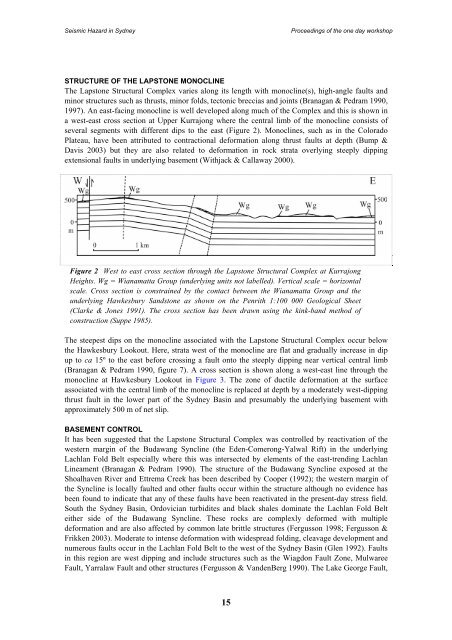Landslides in the Sydney Basin - Geoscience Australia
Landslides in the Sydney Basin - Geoscience Australia
Landslides in the Sydney Basin - Geoscience Australia
- No tags were found...
Create successful ePaper yourself
Turn your PDF publications into a flip-book with our unique Google optimized e-Paper software.
Seismic Hazard <strong>in</strong> <strong>Sydney</strong>Proceed<strong>in</strong>gs of <strong>the</strong> one day workshopSTRUCTURE OF THE LAPSTONE MONOCLINEThe Lapstone Structural Complex varies along its length with monocl<strong>in</strong>e(s), high-angle faults andm<strong>in</strong>or structures such as thrusts, m<strong>in</strong>or folds, tectonic breccias and jo<strong>in</strong>ts (Branagan & Pedram 1990,1997). An east-fac<strong>in</strong>g monocl<strong>in</strong>e is well developed along much of <strong>the</strong> Complex and this is shown <strong>in</strong>a west-east cross section at Upper Kurrajong where <strong>the</strong> central limb of <strong>the</strong> monocl<strong>in</strong>e consists ofseveral segments with different dips to <strong>the</strong> east (Figure 2). Monocl<strong>in</strong>es, such as <strong>in</strong> <strong>the</strong> ColoradoPlateau, have been attributed to contractional deformation along thrust faults at depth (Bump &Davis 2003) but <strong>the</strong>y are also related to deformation <strong>in</strong> rock strata overly<strong>in</strong>g steeply dipp<strong>in</strong>gextensional faults <strong>in</strong> underly<strong>in</strong>g basement (Withjack & Callaway 2000).Figure 2 West to east cross section through <strong>the</strong> Lapstone Structural Complex at KurrajongHeights. Wg = Wianamatta Group (underly<strong>in</strong>g units not labelled). Vertical scale = horizontalscale. Cross section is constra<strong>in</strong>ed by <strong>the</strong> contact between <strong>the</strong> Wianamatta Group and <strong>the</strong>underly<strong>in</strong>g Hawkesbury Sandstone as shown on <strong>the</strong> Penrith 1:100 000 Geological Sheet(Clarke & Jones 1991). The cross section has been drawn us<strong>in</strong>g <strong>the</strong> k<strong>in</strong>k-band method ofconstruction (Suppe 1985).The steepest dips on <strong>the</strong> monocl<strong>in</strong>e associated with <strong>the</strong> Lapstone Structural Complex occur below<strong>the</strong> Hawkesbury Lookout. Here, strata west of <strong>the</strong> monocl<strong>in</strong>e are flat and gradually <strong>in</strong>crease <strong>in</strong> dipup to ca 15º to <strong>the</strong> east before cross<strong>in</strong>g a fault onto <strong>the</strong> steeply dipp<strong>in</strong>g near vertical central limb(Branagan & Pedram 1990, figure 7). A cross section is shown along a west-east l<strong>in</strong>e through <strong>the</strong>monocl<strong>in</strong>e at Hawkesbury Lookout <strong>in</strong> Figure 3. The zone of ductile deformation at <strong>the</strong> surfaceassociated with <strong>the</strong> central limb of <strong>the</strong> monocl<strong>in</strong>e is replaced at depth by a moderately west-dipp<strong>in</strong>gthrust fault <strong>in</strong> <strong>the</strong> lower part of <strong>the</strong> <strong>Sydney</strong> Bas<strong>in</strong> and presumably <strong>the</strong> underly<strong>in</strong>g basement withapproximately 500 m of net slip.BASEMENT CONTROLIt has been suggested that <strong>the</strong> Lapstone Structural Complex was controlled by reactivation of <strong>the</strong>western marg<strong>in</strong> of <strong>the</strong> Budawang Syncl<strong>in</strong>e (<strong>the</strong> Eden-Comerong-Yalwal Rift) <strong>in</strong> <strong>the</strong> underly<strong>in</strong>gLachlan Fold Belt especially where this was <strong>in</strong>tersected by elements of <strong>the</strong> east-trend<strong>in</strong>g LachlanL<strong>in</strong>eament (Branagan & Pedram 1990). The structure of <strong>the</strong> Budawang Syncl<strong>in</strong>e exposed at <strong>the</strong>Shoalhaven River and Ettrema Creek has been described by Cooper (1992); <strong>the</strong> western marg<strong>in</strong> of<strong>the</strong> Syncl<strong>in</strong>e is locally faulted and o<strong>the</strong>r faults occur with<strong>in</strong> <strong>the</strong> structure although no evidence hasbeen found to <strong>in</strong>dicate that any of <strong>the</strong>se faults have been reactivated <strong>in</strong> <strong>the</strong> present-day stress field.South <strong>the</strong> <strong>Sydney</strong> Bas<strong>in</strong>, Ordovician turbidites and black shales dom<strong>in</strong>ate <strong>the</strong> Lachlan Fold Beltei<strong>the</strong>r side of <strong>the</strong> Budawang Syncl<strong>in</strong>e. These rocks are complexly deformed with multipledeformation and are also affected by common late brittle structures (Fergusson 1998; Fergusson &Frikken 2003). Moderate to <strong>in</strong>tense deformation with widespread fold<strong>in</strong>g, cleavage development andnumerous faults occur <strong>in</strong> <strong>the</strong> Lachlan Fold Belt to <strong>the</strong> west of <strong>the</strong> <strong>Sydney</strong> Bas<strong>in</strong> (Glen 1992). Faults<strong>in</strong> this region are west dipp<strong>in</strong>g and <strong>in</strong>clude structures such as <strong>the</strong> Wiagdon Fault Zone, MulwareeFault, Yarralaw Fault and o<strong>the</strong>r structures (Fergusson & VandenBerg 1990). The Lake George Fault,15
















